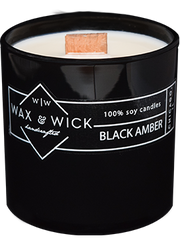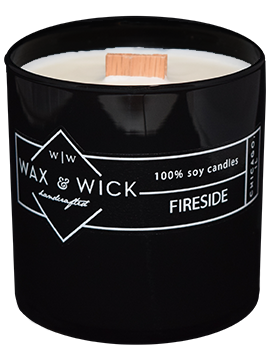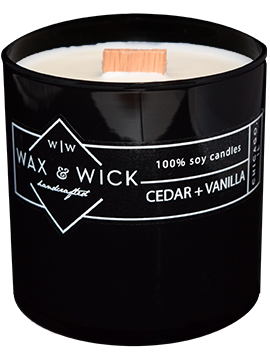Soy Candles
Our 100% soy wax candles are available in a range of enticing scents with wood wicks guaranteeing a longer, more satisfying burn time. Each candle in the Wood and Wick range is made from natural undyed soy wax, which is non-toxic and a better and more sustainable alternative to the many paraffin wax candles o the market.
Browse Our Soy Woodwick Candles:
Soy wax biodegrades and is a fully renewable resources making our candles the most environmentally friendly option, as well as smelling fantastic. Each candle offers a surprisingly clean burn with minimal soot and more burn for your buck, as soy melts more slowly and coolly than paraffin alternatives. All our real soy candles are 100% phthalate free too.
While we may no longer rely on soy candles for light at night, they are still a popular ornamental fixture in many homes. A soy candle can help to set a relaxing mood in any room, whether you’re having company for dinner or enjoying a little “me-time” in the bubble bath. And there’s no need to worry about the smoke, so long as you’re enjoying soy candles rather than paraffin. If you’re concerned about breathing in toxic fumes when you burn candles, you don’t necessarily have to switch to the fake flicker. Soy-based candles offer soft, natural lighting with none of the dangers associated with burning materials such as paraffin wax. Instead of ditching candles altogether in the name of health, you may want to consider switching to a soy candle the next time you’re looking for a little mood lighting.
The Dangers of Paraffin
Paraffin wax was discovered in the mid-1800s, and since then, it’s been a cornerstone of the candle making industry. Most candles that you find today are made of paraffin wax, but unfortunately, it’s not the safest compound to be inhaling as it burns. Paraffin is derived from petroleum and made up of straight-chain hydrocarbons, which combust to produce a dark soot that can get into linens, stain walls, and lead to respiratory problems.
Candles made of paraffin also contain hidden dangers in the form of additives, or chemicals added to wax in order to make the resulting candles look, smell, and burn better. You can find additives derived from petroleum called microcrystallines, which help improve the texture of wax, as well as polyethylenes produced from natural gas that add a glossy finish. Some of the most common compounds found in paraffin candles include:
- Vybar: This polymer raises the melting point of paraffin and allows the wax to blend evenly with scents and dyes.
- Mineral oil: Candlemakers can achieve an attractive mottled effect using mineral oils.
- Polysorbate 80: This compound helps to blend oils and scents into paraffin wax.
- UV light inhibitor: Adding this inhibitor prevents premature fading of colored candles due to sunlight.
Daily use of paraffin candles over the years may contribute to the development of health problems in adults. In one study, researchers at the South Carolina State University found that long-term exposure to certain types of candles can lead to poor air quality and pose a health hazard to a home’s inhabitants. Paraffin candles released undesired chemicals such as alkanes, alkenes, and toluene, all of which are toxic to humans. Inhaling these compounds over a long period can increase the risk of developing chronic conditions such as common allergies, asthma, and even certain types of cancer.
 Ready to try a soy candle? Why not give our Wax & Wick Black Amber Soy Candle a try!
Ready to try a soy candle? Why not give our Wax & Wick Black Amber Soy Candle a try!
While soy candles tend to be slightly more expensive than their paraffin alternatives, you also get more for your money. Soy wax burns at a cooler temperature, meaning that your candle will burn for more hours than a paraffin candle of the same size. The wax is also less likely to scald if touched, which is an important consideration for households with curious little ones.
Why Choose Soy Candles?
Soy candles are made from soybeans, not only making them a safe and natural alternative to petroleum-based paraffin, but also renewable and biodegradable. By buying soy wax products that are hand poured, not only are you helping to support soybean farmers, but you’re also ensuring that the newest addition to your home decor burns clean and won’t detract from your air quality.
When vegetable-based candles such as a soy candle were tested in the South Carolina State University study, they were not found to release any of the pollutants given off by paraffin. They also don’t produce any unsightly black soot, which is not only a pain to clean but is a health hazard as well. With prolonged use, a soy candle may create a fine white residue that’s nontoxic and easy to clean. Soy wax cleans off of just about any surface with a simple solution of warm, soapy water.
Soy Candles are Vegan
If you abstain from using animal products, then you might find candle shopping to be a frustrating endeavor. So many types of candles use animal products! Beeswax comes from the hives of beeves, tallow comes from the fat of animals, and some wax even comes from whales or dolphins. Soy candles are 100% vegan and do not require any animal products in their production or use.
Browse Our Soy Woodwick Candles:
Other Considerations
Even if you make the decision to switch to hand poured soy candles, there are still an overwhelming number of choices available on the market. While soy wax is safe, some candles may contain additional elements that could be harmful to your health. When shopping for a new soy-based candle, there are some questions that you should ask before making a purchase.Are you looking for a scented candle? Our best soy candles can carry aromatherapeutic benefits that are eco friendly, but certain synthetic scents may end up making you sick. You should stick to candles that use natural oils to create a soothing smell. Soy candles tend to hold scent better than paraffin candles because they burn slowly, releasing oils gradually. There are even scents catered towards men, such as the Wax & Wick Oakmoss Soy Candle!
Is the dye safe? Soy wax comes in a natural cream color, but you can also find dyed candles in a spectrum of colors. While colored candles might be pretty, certain dyes contain toxic compounds that may be dangerous if inhaled. You should look for candles that use safe, natural dyes, or purchase from reputable manufacturers that use safe artificial pigments.
Is the wick made of a safe material? Not all wicks are made equal, and some may be downright harmful to your health. Many candles use a cored wick, in which cotton is wrapped around a metal core. Lead was long used as a main component in these cored wicks until the discovery of lead poisoning led to stricter laws regarding its use. Although the U.S. Consumer Product Safety Commission banned the use of lead wicks in 2003, many other countries don’t have as stringent of codes.
When it comes to wicks, it’s best to stick to a non-cored variety made of hemp or cotton. These are generally safe to burn and produce no pollutants. No matter what type of wick you use, however, you should make sure to trim it to ⅛” to keep your candle burning evenly. Keeping your wick at the correct length can also help to prevent the buildup of residue around the candle.
Paraffin candles are popular in homes, restaurants, hotels, and more, but they may pose hidden dangers to our health with long-term exposure. If you’re a fan of candlelight, you may want to consider switching to soy wax candles. They’re renewable, biodegradable, and perhaps best of all, nontoxic.






